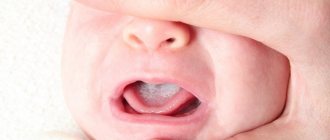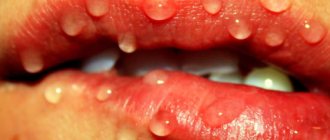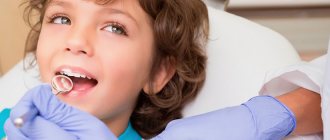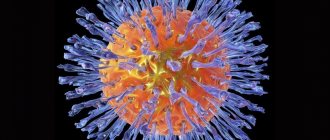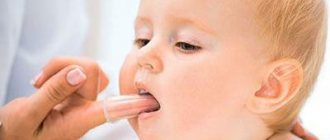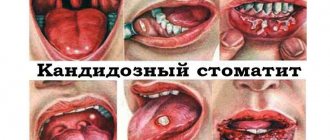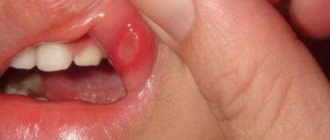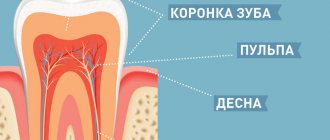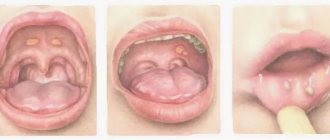Reasons for appearance
Candidiasis is often transmitted to a child from adults; according to statistics, 70% of people are infected with thrush and are its carriers. The disease can be transmitted in different ways, from treating the navel to kissing a baby. The main causes of the disease in children:
- during contact between an adult and a child;
- when processing the umbilical cord in a newborn;
- during breastfeeding;
- through the birth canal;
- through household items (toys, linen, etc.).
White plaque on the lips of a baby
A white film on the tongue of newborns in the period from 0 to 1.5 months is common; the palate, mouth or lips may turn white after milk, because The baby's saliva production is still low. But when whitish spots do not go away, roll into lumps, a layer of white plaque appears on the tongue, in the mouth and on the cheeks, it can be said that the baby has candidiasis.
Thrush in a newborn can be observed both during consumption of breast milk and during artificial feeding. Nursing mothers with thrush must maintain strict hygiene, otherwise the fungus will be transmitted to the baby through the nipple. If a newborn is fed artificial formula, then you need to pay attention to the amount of sugar in the composition, the candida fungus actively develops when its content is high.
Thrush on the lips of a child
- 1 Causes of infection
- 2 Symptoms and stages
- 3 Treatment
- 4 Prevention
White plaque on the lips of a baby is the main sign of candidiasis (in common parlance, thrush). Such manifestations affect not only the lips of a newborn.
Plaque is present on the tongue, gums, and the inside of the cheeks.
If, despite all the listed signs, there are no white spots on the baby’s lips, this may be a manifestation of other diseases: viral stomatitis, dysbacteriosis, gastritis with high acidity, or simply a plaque after feeding that goes away on its own.
Causes of infection
Oral thrush is a disease caused by a fungus of the genus Candida and is widespread among infants. Candida is present in the body of any person, but the disease is provoked only by weak immunity.
Newborn babies are most susceptible to thrush because their immunity has not yet fully developed. An experienced pediatrician is able to detect the disease at its first signs, but young mothers often confuse candidiasis with milk residues after feeding or after regurgitation.
Thrush on the lips of a child occurs when the immune system is weakened. This is the main, but not the only cause of the disease. The main source of infection for a baby is the nursing mother.
According to statistics, children become infected with thrush from adults in 70% of cases.
Starting from 6 months of age, there is a risk of infection with insufficiently treated toys and teethers.
Infection can occur:
- Through the birth canal, if at the time of delivery the woman had untreated thrush.
- During treatment of the umbilical wound of a newborn.
- In case of close contact of a carrier of infection with a child.
- During breastfeeding, if the nursing mother does not comply with breast hygiene.
But even when infected with a fungus of the genus Candida, the disease does not always manifest itself in children. Breastfed children have a stronger immune system than formula-fed children. If a nursing woman maintains breast hygiene, she reduces the risk of infection of the baby, and along with the mother’s milk, antibodies enter the baby’s body, helping it resist diseases.
As for babies who are bottle-fed, to reduce the risk of candidiasis, the mother should carefully consider the choice of formula.
It is better to give preference to breast milk substitutes, whose sugar content is minimal. In a sweet environment, Candida multiplies many times more actively.
Eating sugar, mushrooms release toxins that weaken children's immunity.
The condition of a baby's immune system can also deteriorate during teething or colds.
If the baby gets sick often, then to increase the protective functions of his body, the pediatrician may recommend prophylaxis with immunomodulators approved for use in newborns (rectal suppositories Viferon or Kipferon).
Symptoms and stages
At the initial stage of development, thrush does not cause the baby much discomfort. Externally, it manifests itself as slight redness on the tongue, the inside of the lips and cheeks.
After a few days, they begin to become covered with a white coating that resembles cottage cheese. To understand that it is thrush, you should lightly run a clean napkin over your tongue or lips.
The remaining food will be removed, but if it is a fungal coating, it will remain in place.
If you suspect thrush in a child, you should immediately show him to the pediatrician, and, if suspicions are confirmed, strictly follow all the doctor’s recommendations. Neglected or untreated candidiasis becomes chronic, which is very difficult to combat.
Depending on the intensity of the manifestations, three stages of thrush are determined:
- Initial (mild form). The baby does not show much concern; in his mouth there are small spots of plaque, similar to cottage cheese.
- The second stage is characterized by an abundance of white spots in the baby’s mouth. If you try to remove the plaque, there will be bleeding ulcers underneath. The child is capricious, sleeps poorly, refuses to breastfeed, and loses weight. At this stage, the disease may be accompanied by moderate hyperthermia (up to 37.5 degrees).
- At the third stage, the disease takes on a severe form. The entire oral cavity is covered with a white coating; it can also spread to the larynx. The baby's body temperature can rise to 39 degrees, and the lymph nodes enlarge.
In an advanced form of thrush, the oral cavity and larynx become covered with a dense coating, and the disease spreads to the internal organs.
Lack of treatment can lead to dehydration and candidal sepsis. Premature babies have a high risk of death.
Prevention
Fungi of the genus Candida can cause serious harm to the health of a newborn. In order to prevent infection and development of the disease in the baby, a woman should worry about sanitizing the birth canal already at the stage of gestation. After the birth of a child, a young mother should also pay increased attention to both personal hygiene and caring for the newborn:
- Keep your baby's feeding utensils and toys clean.
- Do not lick nipples, pacifiers, spoons.
- During breastfeeding, wipe the mammary glands with a soda solution before each feeding.
- After feeding, give the baby a teaspoon of boiled water.
- In hot weather, do not forget to give your baby water between feedings.
- Maintain normal air humidity in the children's room.
- Spend more time outdoors with your child.
Infantile thrush is a serious condition, although it may seem harmless at first. On the other hand, if the problem is detected on time and the doctor prescribes competent treatment, within a week there will be no trace of the disease. The main thing is to closely monitor the baby’s health and, at the first suspicion of candidiasis, seek professional help.
Source: https://MoyaKoja.ru/gribkovye-bolezni/drugie-gbolezni/belyj-nalet-na-gubax-u-grudnichka.html
Factors influencing the occurrence of the disease
Candida bacteria live in the body of almost every person, but they do not always lead to the development of thrush. The following factors can provoke the disease in a child:
- previous colds, acute respiratory viral infections;
- internal chronic diseases;
- diabetes;
- appearance of the first teeth.
External factors also influence the development of fungus, such as:
- contacts of the baby with infected adults;
- artificial feeding;
- prematurity;
- toys, household items with fungus settled on them;
- poor hygiene by a nursing mother.
How to treat
Only a doctor can decide this. Therefore, do not delay your visit to your local pediatrician, who will prescribe therapy based on the examination results. Do not self-medicate under any circumstances! This, especially for a small child, can only cause harm.
Modern treatment methods have a wide arsenal of all kinds of antifungal, anti-inflammatory, and disinfecting agents. At the same time, methods of alternative medicine are not overlooked, in particular a 2 percent solution of baking soda.
Treatment
The best treatment option is a combination of drug treatment and folk methods that have been proven over the years. Thrush on the lips of a baby is treated with antifungal drugs; You must first remove the white plaque on the child’s lips and other areas; it is recommended to wipe the spots with special solutions: Lugol’s solution, Pimafucin suspension. If candidiasis has caused complications of internal organs, then doctors may prescribe treatment with antibiotics and systemic medications.
Thrush on a child’s lips can occur in three stages: mild, moderate and severe. If during the first stage the baby does not have anxiety or fever, and only the appearance of cheesy discharge is observed, more often on the lower parts of the lips, then you don’t need to panic and use traditional medicine methods. But if the child’s entire oral mucosa, mouth and lips are covered with a dense white coating, a fever is observed, pain and itching are possible, then consult a doctor immediately.
Drug treatment
The main thing in treating thrush in a child is treating the oral cavity with solutions of soda and antifungal drugs. Up to 6 months is the basis of treatment, since pills are not prescribed at this age. But for boys and girls older than six months, such treatment is a mandatory component of treatment. Table of medications used by age:
| Age | Facilities |
| Up to 6 months | treating the affected oral cavity with a one percent soda solution; Candide solution (use only as prescribed by a doctor) |
| After 6 months | Miramistin and Candide solution are used to treat affected areas; antifungal drugs Fluconazole or Diflucan (for moderate and acute forms of the disease) |
| Over 1 year old | treatment with Miramistin, Lugol's solution or Nystatin. Nystatin can be used in tablets; it is better to crush it first; if the disease causes discomfort in the child (itching or pain inside the mouth), antihistamines can be used |
Antifungal drugs
Pimafucin is a drug intended to combat fungi, including Candida. Available in tablets, cream, drops, vaginal suppositories for the treatment of thrush in girls, suspensions. Advantages – practically does not cause adverse reactions. Disadvantages - expensive, there are no analogues on the market that fully correspond to the drug.
Nystatin is an antifungal agent for the prevention and treatment of candidiasis. Available in tablets and granules, a suspension is prescribed for children. The effect of the drug is local and is not absorbed into the blood. Advantages: easily portable, effective and safe for children, low cost. Disadvantages - requires long-term use, has a weak effect.
Candida solution is an antifungal agent used to treat thrush in children. Advantages - no side effects, can be used even by newborns, highly effective, does not require long-term use. No deficiencies identified.
Folk remedies
Treatment with home methods for candidiasis is very effective; doctors themselves often recommend using herbal decoctions. Thrush in a child can be treated:
Calendula. A decoction of flowers is used to treat the white areas of the lips and the inside of the oral cavity several times a day, the procedure is carried out carefully so as not to damage the child’s mucous membranes, the decoction relieves inflammation and heals wounds.
Soda. A 1% consistency of soda solution is applied to the affected areas, the alkaline reaction breaks down the candida fungus.
Chamomile. Initially, the baby’s mucous membrane is wiped with a soda solution, then you need to remove the plaque with chamomile infusion.
Potassium permanganate. Make a pink solution and treat areas with plaque 3-4 times a day.
Symptoms and signs
A characteristic sign of thrush is a white coating, reminiscent of liquid cottage cheese or sour milk, on the surface of the lips. As a rule, it first appears on the lower lip, which swells and turns red. Next, the process spreads to the internal mucous membranes - gums, cheeks, palate.
The clinical picture of the disease is as follows:
- sponges become very dry and begin to peel;
- cracks appear that may bleed;
- the mucous membranes are covered with a thin whitish film, which is very difficult to remove;
- then lumps appear, reminiscent of sour milk;
- mucous membranes become red, swollen, erosions appear;
- When breathing, a specific smell of sour milk is felt.
A sick baby becomes capricious, refuses food, sleeps poorly, and cries often.
What does thrush look like on a child's lips?
The parent himself can recognize the onset of the disease by its characteristic appearance. A photo of thrush on a child’s lips will help family members recognize the “enemy” even before visiting the pediatrician.
IMPORTANT!!! Only a doctor can prescribe effective and safe remedies for the baby, since the treatment has certain specifics. If proper treatment is carried out in the acute period, the fungus dies and leaves antibodies to most subspecies of “its fellows.”
Prevention of thrush in newborns
Candida fungi cause great harm to the health of children and contribute to a decrease in immunity, therefore, in order to protect the child from thrush, it is recommended to take preventive measures. Always maintain good oral hygiene for your baby to avoid introducing bacteria (through unwashed hands, dirty toys, pacifiers, etc.). Parents should also always carefully observe hygiene when in contact with the child and maintain order in the house.
Monitor your baby's nutrition; children who suckle at the breast can become infected from their mother's nipple; it is advisable that the breasts be treated with a soda solution before feeding. The baby may bite the nipple, after which it will begin to bleed, at which point the infection is transmitted from mother to child through the wounds. Watch the level of sugar in your diet; candida fungi actively develop in a “sweet” environment.
Possible complications and prevention of occurrence in infants
Thrush in infants is a common occurrence, but you should not self-medicate and ignore the symptoms that appear. If measures are not taken in a timely manner, white plaque can completely affect the oral cavity, cheesy lumps harden, and if you start to remove them, bloody wounds may appear. The child’s well-being worsens due to intoxication caused by the rapid proliferation of fungal colonies, which can affect internal organs and provoke the development of chronic diseases. To avoid complications, you need to seek medical help; only a doctor can assess the situation and prescribe drug therapy in accordance with the child’s age.
It is best to prevent the development of thrush in infants and older children by following certain preventive measures:
- protect from close contact with others so that the child cannot become infected;
- carefully observe body hygiene before feeding the baby; you can use soda solution for the nipples as an antiseptic;
- clean the oral cavity of milk and food residues after each feeding;
- maintain cleanliness in the house, sterility of the child’s personal belongings and toys;
- use clean vegetables and fruits for cooking;
- limit your consumption of sweets;
- strengthen the immune system with vitamins and hardening.
With careful attention to the mucous membrane and general condition of the baby, the appearance of thrush can be avoided. Following simple rules will reduce the risk of fungal infection several times. And if the first signs of the disease appear, a timely visit to a doctor will help you quickly get rid of the unpleasant problem.
The article has been verified by the editors
How to determine if a newborn has candidiasis
This will not be difficult, since the hallmark of thrush in the mouth is the appearance of a white coating that can cover the tongue, gums, inner surface of the cheeks, palate, tonsils, and tonsils.
Thrush spreads to the back of the pharynx in the absence of the necessary therapeutic measures. In very rare cases, the fungus can affect the baby's esophagus and even intestines.
A specific coating, similar to semolina grains (in advanced cases, it can resemble particles of cottage cheese) is the primary sign of thrush.
There are also secondary symptoms that usually appear simultaneously with the main symptom of the disease:
- poor appetite (refusal to breastfeed or bottle);
- crying during feeding;
- sleep disturbance at night;
- general malaise;
- moodiness and irritability;
- redness of the mucous membranes of the oral cavity, wounds and ulcers;
- an increase in temperature to 37-38 degrees (in cases where a bacterial infection is associated with a fungal infection).
The appearance of such symptoms is a reason to call your local pediatrician or consult with a pediatrician online.
Help
Treatment of thrush in infants is complicated by the fact that such a child will not be able to complain and describe his state of health. Therefore, parents need to be attentive to the baby, and at the first signs of illness, go to see a pediatrician. If candidiasis appears from frequent regurgitation, in such a situation it is important to find the cause of this phenomenon and eliminate it. Perhaps the baby does not grasp the pacifier correctly when feeding, and excess air enters the stomach, which provokes regurgitation.
To get rid of thrush in an infant, you need to treat the baby’s oral cavity with the following remedy:
- Dissolve a teaspoon of baking soda in warm water. Soak a gauze swab in the solution and treat the child’s oral cavity. It is recommended to carry out this procedure as often as possible. At an early stage of appearance, thrush can be cured within 5-10 days.
- Make a weak solution of potassium permanganate and treat the oral cavity with a swab dipped in it.
Newborn therapy
After birth, babies develop candidiasis, as they tend to burp frequently. Every mother should try to improve her feeding technique as much as possible.
At an appointment with a pediatrician, you can learn how to remove thrush from a newborn. There are two main ways to do this:
Soda. Add 1 teaspoon of soda to a glass of warm water. Wipe the white areas on the tongue with a prepared soda solution every 2 hours.
Manganese. Wipe the affected areas in the child’s mouth with the medicinal solution.
It is possible to cure candidiasis in a six-month-old child in the same way as in a baby. The only difference is in the medications: Nystatin, Miramistin and Candide.
Streptoderma in a child: first manifestations of the disease, treatment options and main symptoms of the diseaseConjunctivitis in a child - causes, symptoms, diagnosis and treatment in children and adults (95 photos and videos)
- Ergoferon - detailed instructions for use and consultation with a doctor (95 photos)
Prevention of lip candidiasis in children
Prevention is always easier than cure. Moreover, preventive measures in this case are aimed at generally strengthening the baby’s defenses and protecting him from harmful external factors.
- Hygiene. This is the very first and most important rule. Observance of all necessary measures by parents when contacting their child.
- Handling the child’s personal belongings – bottles, nipples, cups, spoons. Also keeping clothes perfectly clean and ironing, especially for newborns.
- Treating toys with disinfectant solutions. It is not recommended to buy soft toys for small children or those that cannot be subjected to heat treatment or washed in special antiseptic solutions.
- General strengthening procedures - hardening, walks in the fresh air (preferably in any weather, but without fanaticism), clothing according to the season.
And most importantly - rational and high-quality nutrition. If this is breast milk, then the mother must carefully monitor her diet, make it varied, safe and healthy not only for herself, but also for the baby.
Next, parents should pay attention to the proper nutrition of their offspring. But you should not succumb to the “provocations” of your beloved child and spoil him with too many sweets and foods with food chemicals. This will not bring anything good to a growing body.
Symptoms
To identify the disease, you will need to know what signs you need to focus on first. Let's highlight the main ones:
- the baby refuses to eat the moment his mouth is placed on the mother’s nipple or feeding container;
- poor baby sleep, frequent restlessness and crying for no reason;
- frequent regurgitation, the cause of which is plaque in the mouth;
- systematic weight loss.
If the baby has the above symptoms, what needs to be done initially is to look into the baby’s mouth and make sure there is plaque on the tongue. Then you also need to examine the genitals.
If signs of candidiasis are confirmed, you can initially be treated with Nystatin or Miramistin. These products are not dangerous for children due to the absence of side effects.
However, consultation with a pediatrician is still necessary. Perhaps such symptoms indicate other problems in the child’s body.
